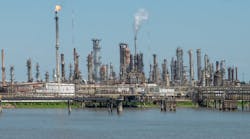In spite ongoing supply chain constraints, the American chemical industry expects to deliver solid growth this year as it benefits from inventory rebuilding, steady demand across many end-use industries and a continued competitive advantage in natural gas-based chemistries.
This is the conclusion reached by the American Chemistry Council (ACC) Mid-Year 2022 Chemical Industry Situation and Outlook report.
“Following several years of weak growth related to trade tensions, COVID-19, and disruptive weather events, chemical output is looking to have its best year in more than a decade in 2022, with expansion across all chemistries,” says Martha Moore, ACC chief economist, managing director and author of the outlook.
“Investment in sustainability solutions – from innovative lower-emissions technologies to advanced recycling and recovery – will increasingly be a key driver of chemical industry capital spending,” she adds.
ACC’s industry outlook review begins with a review of the global economy, which continues to struggle with supply chain problems and inflation, exacerbated by the Russian invasion of Ukraine and COVID-related lockdowns in China.
“While these challenges are likely to persist, slower growth in consumer spending and shifting consumption patterns away from goods should help relieve some pressure,” the council says. The council projects Global GDP will grow 3.2% in 2022 and 3.2% in 2023, while industrial production will grow 3.9% in 2022 and gain 3.6% in 2023.
In the United States, several economic growth drivers remain in place, including strong employment, healthy household and corporate balance sheets, and solid manufacturing growth, according to ACC.
Despite a contraction in the first quarter, Gross Domestic Product (GDP) is expected to grow by 2.8% in 2022 and 2.1% in 2023 after a 5.7% gain last year, the council’s researchers point out. It forecasts that business investment will grow 5.7% in 2022 and 3.5% in 2023 after gaining 7.4% in 2021. ACC also forecasts that the unemployment rate will average 3.6% in 2022 and 3.7% in 2023 after a 5.3% reading last year.
Demand for the industry’s products is being driven by technological innovations taking place in different fields, For example, the manufacture of lighter-weight vehicles designed to lessen their impact on the environment is an important end-use market for chemistry, with over $3,200 in chemistry going into each vehicle produced. These lighter-weight vehicles also improve fuel economy and increase safety, according to ACC.
The council points out that many plastic components can weigh 50% less than similar components made from other materials. Modern innovations mean today’s plastics make up 50% of a vehicle’s volume, but only about 10% of its weight.
Overall U.S. vehicle manufacturing is recovering, but shipping constraints and disruptions to supply chains for vehicles and parts, especially in Europe and China, are limiting supply. Pent-up demand is expected to provide a push to sales once supply chain constraints ease. ACC expects vehicle sales to edge higher to 15.1 million in 2022 and 16.3 million in 2023, compared with a pre-COVID level of 17 million in 2019.
Supply Chain Woes
A shortage of semiconductors continues to constrain global vehicle makers, the council observes. U.S. vehicle assemblies are recovering, but shipping constraints and disruptions to supply chains for vehicles and parts, especially in Europe and China, are limiting supply.
ACC and its members are deeply involved in trying to find legislative and regulatory solutions to the railroad service crisis in the U.S., which has hit chemical producers particularly hard. The rail crisis has impacted everything from livestock feed and fertilizer to chemicals essential for the treatment of drinking water and production of diesel and other fuels.
The council also was involved in lobbying Congress to pass the bipartisan infrastructure funding bill and supports projects and activities aimed at reducing the national truck driver shortage, like apprenticeship programs aimed at younger drivers.
Assuming that actions taken by industry and government leaders can tame some of the supply chain issues later this year, the chemical industry will reap the benefits of a growing housing industry. Housing starts climbed to 1.60 million in 2021 and are expected to rise to 1.65 million in 2022, then ease to 1.57 million in 2023.
Affordability constraints including higher prices and mortgage rates will create headwinds to further expansion in the housing industry. However, ACC stresses that gains in employment, wages and household formations will be supportive of economic growth.
As a result, ACC predicts that U.S. chemical output is looking to have its best year in more than a decade in 2022, with growth across all chemistries. After a 1.6% gain in 2021, ACC expects output to grow by 4.1% in 2022 and expand 2.4% in 2023. It says shipments will grow 9.6% in 2022 and 3.4% in 2023 after an 11.3% gain last year.
ACC also predicts that basic chemicals will increase by 4.3% in 2022, with the largest gains in bulk petrochemicals and organics (4.6%), plastic resins (4.4%), and inorganic chemicals (4.4%). Specialty chemicals output should grow 6.2% in 2022, pulled by strong demand and restocking. The industry’s capital spending will jump 12.3% in 2022, to $34.5 billion, and 5.5% in 2023, to $36.4 billion
Chemical industry payrolls expanded in 2022, with strong growth through mid-year. Employment actually surpassed pre-COVID levels in January, and the industry is projected to add more than 11,000 jobs (up 2.2%) in 2022. The council sees job growth continuing through the forecast horizon, with gains of several thousand per year.
“The chemical industry remains a major U.S. employer. Its workers are among the highest-paid in the manufacturing sector—averaging more than $90,000 in 2021—and those earnings support local communities,” ACC explains.
The total chemicals trade rebounded in 2021, rising by 26.8% over the previous year to reach $281.4 billion. In 2021, imports increased by 32.7% and exports rose by 22.3%. Gains were led by the petrochemicals trade, which continues to drive trade expansion heading into the first quarter of 2022.
Nominal chemical exports are forecast to grow 13.3% in 2022, to $173.5 billion, while imports will rise 19.7%. As the pace of imports growth exceeds exports, the U.S. chemicals trade surplus will fall to $19.9 billion in 2022, ACC projects.
In addition, the council believes that the chemicals trade will moderate in 2023 and return to a modest growth trend through 2026. It says net exports of chemicals are expected to reach $35.2 billion by 2026.
One wild card is the explosion of proposals that seek to restrict, and in some cases eliminate, the use of certain chemicals believed to threaten public health and contribute to climate change dangers. ACC has tried to stay ahead of these issues by working with policymakers to embrace some restrictions while fighting policy prescriptions that it believes go too far.




